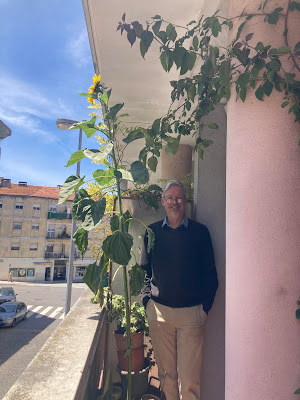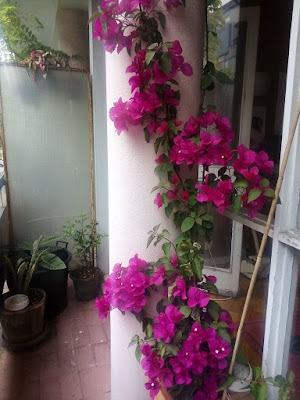This post describes an experiment in composting that ultimately led me to create a worm composter, which is where I'm currently at as far as this ongoing experiment is concerned. This doesn't mean that micro-compos are a bad idea. They worked well and made us self sufficient in terms of fresh earth for our plants.
However, I suspect that worm composters are more efficient and more convenient. I've therefore decided to continue my experiment in that direction. But for anyone interested in micro-composting, here's what we did.
*
My wife and I have a balcony with twenty or so potted plants. To keep these plant with nutrients, we add so called "plant food" to their water every now and again. However, we've recently come across a better way to keep our plants healthy. Instead of giving our plants artificial nutrients, we've put tiny composters into the flower pots.
 |
| Micro-compost |
These are 1 litre plastic bins that we've cut into to allow for air circulation and direct contact with the earth. Holes are cut along the top for air supply, and a hole is cut into the bottom.
 |
| Micro-composter cut from plastic bin |
 |
| Bin with kitchen refuse |
Easily composting refuse are anything vegetable, with the exception of seeds. Egg shell, tea leaves and coffee are also good. A healthy compost should have some dry leaves in it as well. This can be collected from the potted plants themselves. A few peanut shell and small twigs can also go into the composters to keep them from getting too wet.
Positive effects on plants
The effectiveness of our composters has been remarkable. Our plants reacted positively from the very start, immediately producing new shoots and denser and healthier foliage.
 |
| Fresh shoots |
The composters are currently compacting refuse at a rate of about a centimetre or two every day, which translates to a requirement of 4 litre of composters for each person in our household. We have a diet relatively rich in vegetables, so people with a less vegetarian diet will require less while strict vegetarians may need an extra litre per person.
Procedures
Our experience is that healthy compost is best created by filling several bins in parallel so that bugs and bacteria can evolve naturally into the refuse before we move onto the next bins. Our routine is as follows:
- Ready several bins by picking them up and dumping their content into a bucket together with some regular soil.
- Leave a little compost in each bin to seed the next lot with bug eggs and bacteria.
- Fill the bins in descending quantities over the next few days until the first ones are full.
- Close the full ones, ready new ones as needed, and carry on.
Compost needs air circulation in order to work. This is the reason for the soil added to the bucket where we dump our fresh compost. Without the soil, the compost lumps together into a sticky mess. However, with the added soil, composting continues in the bucket.
Even better than a bucket is a large flower pot with holes in the bottom, put on top of regular soil, so that water drains out into the soil below, and worms and bugs find their way up through the holes.
We're currently experimenting with an arrangement of flower pots stacked on top of each other. The idea is to get the best possible environment for the final part of the composting process. The challenge is to get the right mix of soil, compost and dry leaves for maximum efficiency.
 |
| Flower pots for final stage of composting behind a sunflower |
As for the micro-composters, it's important to resist the temptation to push refuse into the bins to get as much as possible into them. If pushed into the bins, composting will be retarded due to lack of air, and there will be a smelly sticky mess instead of a nice healthy compost.
When filled correctly, there will be at first a pleasant sweet smell of freshly cut grass coming from the bins. This smell turns gradually towards a smell of damp forest.
 |
| Composters and bucket |
Every now and again, we take compost from our bucket and spread it out like a "forest floor" for our plants. It's surprising how much can be given to the plants in this way. Compost dissolves naturally into the soil below, so much so that we're able to consume all of it ourselves.
Compost that has been spread out on soil outdoors dries up and becomes odourless over time. At that point it can be scraped off and taken indoors for house plants so that these too can benefit from our production.
 |
| Compost dumped to free up space |
Micro-composts attract fruit flies and other insects, but these don't stray far from the bins. Very few find their way into our apartment, and a few fruit flies fluttering around here and there is not of any great concern to us. It's not like they are all over the place. In fact, one of the charms of this is the great variety of insects that our micro-composts attract. Our balcony is no longer a sterile display of flowers and plants, but a buzzling place of activity. It looks, smells and feels like a proper garden.
Keep in mind that insects are most active when the air is warm. In the cool morning air, fruit flies can hardly fly, so it's a good idea to fill the composters early or late in the evening, and to keep from disturbing them during the hot hours of the day.
Observations
Two years into this project, we've noticed a reduction in fruit flies. Our eco-system is more balanced. Instead of only a few types of insects, we have a large variety, and many of the newcomers appear to be fond of fruit fly larva.
Our initial fear that our apartment might get invaded by bugs has also been laid to rest. We have no more problems with insects entering our apartment these days than we had before we started this experiment.
 |
| Contemplating life over a cup of coffee |
The positive effect on the plants from the micro-composts was so immediate that I concluded that most of the effect must have been due to the production of CO2 rather than nitrogen from the compost itself. It appears that we've stumbled on a verification of one of NASA's claims. Namely that our planet is greening due to increased CO2 in the atmosphere. Additionally, we can conclude that most composting and gardening is currently done wrong. Composting shouldn't be done in big heaps, separate from the garden, but in small heaps among the plants themselves. When done at this scale, no other fertilizers are needed.
There's also less need of pesticides because micro-composts attract a variety of insects, many of which are predators that eat pests like aphides and caterpillars. The annual invasion of slugs that we've been having every fall have been reduced, most probably due to the composts. However, we've also had fierce pest attacks due to temporarily imbalances, probably introduced into our composts from kitchen refuse. These attacks have been limited in scope. The overall effect of the composts has been positive, but it would be a lie to say that pests are completely gone.
We made no special effort to seed our composts when we started this project. Apart from a little dirt gathered from a local garden, we added nothing to the sterile soil. However, we now have all sots of insects. We even have earth worms. How they got into our compost is a mystery. They weren't there to start with. But half a year into our project, we got a few specimens in one of our pots and they have since spread to all pots and multiplied to a number consistent with what can be expected in a well composted garden.
The earth worms have had the effect of speeding things up, and they produce a more earth-like end product. They eat into the fresh compost left behind by other organism, completing the process of turning refuse into soil. Their effect on the whole process has been remarkable.
 |
| Wax plant with bee |
It's clear that the micro-composters create a micro-climate and eco-system much to the liking of our plants and insects. Even birds have been attracted to our balcony. While they have no interest in the composters, they do at times scurry through the forest floor in search of beetles and worms. This leaves a mess on on the balcony floor, and can cause damage to the plants.
The solution to this problem is to open the bucket where the final stage of composting is taking place. This is where the majority of worms and bugs live and birds will home in on this. They will eat bugs and leave bird turds instead. The birds are fed without leaving a mess or damaging our plants, and we get compost rich in nutrients.
Our balcony has become an eco-system, with life forms ranging from bacteria and fungus, to plants, insects, and birds. Finding this fascinating, we've involved our son in this and challenged him to make a picture of what's going on. This is what he made with some help from his father:
 |
| Bougainvillea |
 |
| Confused Margarita |
 |
| One of two large bins |
Some plants love their soil as rich as possible while others like it less so. The trick is to find the right balance of dirt and compost and the right type of plants. Instead of looking for plants that require little compost, we're now making a point of finding plants that consume large quantities of it.

No comments:
Post a Comment